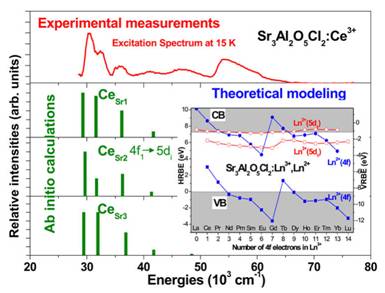The energy level structure formation of phosphors is the key issue to investigate and predict the superb luminescence properties of relevant lanthanide doped into lattice. However, the distinguishment of the dopant Ce3+ 5d energy with different surrounding coordination environment has limited the further study on its potential application when Ce3+ is doped into host lattice with multi-cationic sites. Recently, a team from school of Chemistry and Chemical Engineering of Sun Yat-sen University cooperating with Professor L. X. Ning from Anhui Normal University has gained insight into the urgent issue and discussed the correlation between quantum calculation and experimental result. Their research has been published in J. Phys. Chem. C. (J. Phys. Chem. C 2015, 119, 6785−6792) 
Photoluminescence properties of Ce-doped Sr3Al2O5Cl2 crystals prepared by a solid-state reaction method are first investigated with excitation energies in the vacuum-ultraviolet (VUV) to ultraviolet (UV) range measured at BSRF (Beijing Synchrotron Radiation Facility) 4B8 experiment station. Six bands are observed in the excitation spectrum of the Ce3+ 5d→4f emission at 15 K. The highest energy band is attributed to the host excitonic absorption, from which the band gap energy of the host is estimated to be around 7.2 eV. The four lowest energy bands are assigned to the 4f1→5d1-4 transitions of Ce3+ located on the three distinct Sr2+ sites in Sr3Al2O5Cl2 with almost equal probability, based on a comparison between excitation band maxima energies and 4f →5d transition energies obtained from wave-function-based CASSCF/CASPT2 calculations with spin-orbit coupling on Ce-centered embedded clusters. The 4f1→5d5 transition, not observed in the low-temperature excitation spectrum, is found to be overshadowed by a nearby defect-related excitonic absorption. On the basis of present experimental and calculated results for Ce-doped Sr3Al2O5Cl2, the energy-level diagram for the 4f ground states and the lowest 5d states of all trivalent and divalent lanthanide ions on the Sr2+ sites of Sr3Al2O5Cl2 is constructed and discussed in association with experimental findings. By the combination with quantum calculation result and experimental spectral information, the researchers consider that it provides new opportunities for dealing with the complicated identification of Ce3+ 5d energy in lattice with multi-cationic sites. Article: Rui Shi, Minmin Qi, Lixin Ning*, Fengjuan Pan, Lei Zhou, Weijie Zhou, Yucheng Huang, Hongbin Liang*. Combined Experimental and Ab Initio Study of Site Preference of Ce3+ in SrAl2O4. Journal of Physical Chemistry C, 2015, 119 (33), 19326-19332. |


